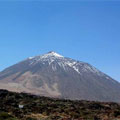
A lot has been written about Teide and it could not be otherwise, because there are sufficient reasons to support this statement. This is not just any volcano, if we take into consideration that Teide and Las Cañadas are more than 100 000 years old. However, the attractions of its solid structure began to multiply ad infinitum from the earliest sailors’ arrival to the islands.
There are no copies of the most desired documents about this early period, but we must remember that Tenerife was conquered in 1496 and consequently, a number of changes have taken place from that period onwards.
Abreu Galindo, a writer, stated something of utmost importance in 1632: “Some have called this island of Tenerife the Isle of Hell, because of the so many sulfur stone fires and the Teide Peak, giving out a lot of fire”. However, the earliest direct quote ever recorded was made by the English merchant Thomas Nichols, who published a voyage book in 1583 stating the following: “This island is 17 leagues long and the land is high, just like the top of cultivation land in certain parts of England. In the middle of this region there is a round mountain called Teide Peak, situated as follows: The summit of the peak to the top following a straight line is over 15 leagues long (45 English miles), fire and ashes coming out of it from time to time and it may be half a mile around.
The top is shaped like a kitchen boiler. In about two miles around the top there are only ashes and pumice stone and below these two miles is the cold area, covered with snow all year long”.
It has been duly written for a documented conference that “It was the Enlightenment which furnished Teide with one of its most significant features: its relation to the history of science and geographic discoveries. Teide’s history is closely linked to the new scientific and technical achievements of a period that was called by the people of that time, who were full of enthusiasm, “the age of reason”.
Physics, mathematics, cartography, geodesy, botany, zoology or mineralogy of the 18 th century benefited from Teide as a natural laboratory and a geographic landmark.
“The Age of Enlightenment was marked by the development of sea trade and the beginning of great scientific expeditions. European sailors were familiar with the average contour of emerged lands, including the newly discovered southern continent”.
“Exploitation of new territories required the improvement of scientific techniques and methods. Canaries have a great advantage: it is an unavoidable crossing by sea and Teide is the beacon guiding sailors on this side of the Atlantic. Likewise, it used to be said with absolute certainty that merchants, scientists -and even pirates- reached its ports.
Many years later, on board the frigate La Flore, J. Ch. Borda, a mathematician and geodesic, who also organized a climb to Teide, developed a monograph about the islands, providing interesting data on the population, customs and economy. What he wrote to explain his work is very significant: “Measuring Tenerife’s peak was no mere curiosity for us, as it was essential for our nautical work. It was indispensable for us to know the volcano’s exact elevation to benefit from apparent height observations that we had made in different points of Tenerife, Gomera and Canary islands and would serve to determine those points’ lengths and latitudes”. Teide’s height was a problem that spread over a whole century and when it was solved it put and end to the legends about it at that time.
From every point of view, it is enlightening to know part of the great history of this extinguished volcano of 12 198 feet in height ( 3 718 m), which became the highest mountain in Spain with the privilege that its top can be spotted from any of the other Canary Islands.